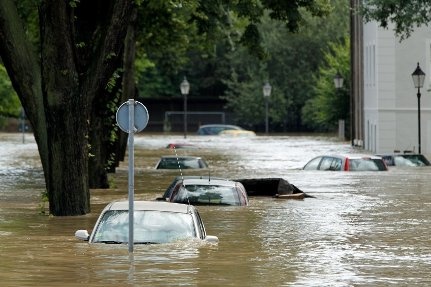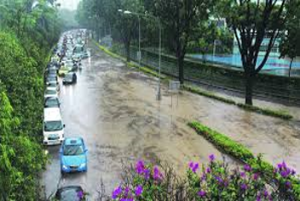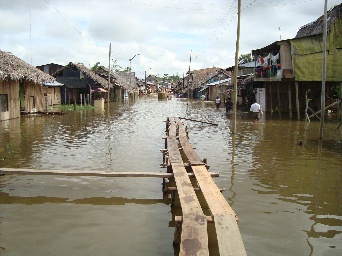Flooding
Flooding is a worldwide problem causing massive loss of life and destroying housing, infrastructure and agriculture. Floods in Europe have caused some 1126 deaths, the displacement of about half a million people and at least €52 billion in insured economic losses (source: EEA). Since it is predicted that climate change will even increase the frequency of flood events, the European Union has developed the Flood Risk Directive (FRD) which requires EU Member States to undertake a preliminary assessment of flood risks and, for areas with significant flood risk, to prepare flood risk maps and management plans. In cooperation with the national flood forecasting centres of member states, the European Commission’s Joint Research Centre has launched the European Flood Awareness System (EFAS) which aims to prepare for and mitigate impacts from flooding. The forecast and simulation of floods is essential for flood management and early warning and since conventional means to record hydrological parameters often fail to accurately predict an extreme flooding event, satellite remote sensing technology has become the key tool for flood monitoring in recent years.
In 2010, the Neisse river near the town of Görlitz, Germany was at the highest level ever recorded in the almost 100 years of systematic measurements. Credit: Getty images
Earth-observing satellites can provide vital information to mitigate and prepare for disasters. Optical and radar remote sensing technologies are excellent tools in the mapping of the spatial distribution of flood related data within a relatively short period of time. Satellite derived information to predict weather-related disastrous phenomena, such as extreme storms and rainfall, are widely known and frequently utilized. Satellite remote sensing data can be used before, during and after a disaster, for prevention, monitoring, mitigation and relief operations, respectively. Different satellite technologies can be applied for various types of flooding. There exist essentially two general categories of flooding; river floods, which can be seasonal and are related to big rivers or flash floods in smaller catchments, and coastal floods which are related to tropical cyclones or to high tides.
Various factors are of importance in the occurrence of flooding, such as the intensity and duration of rainfall, snow melt, deforestation, poor farming techniques, sedimentation in river bed, and natural or man-made obstructions. To forecast and manage flood hazards, various parameters should be assessed such as the flood frequency, the depth of water and duration of flood, the flow velocity, and the rate of rise and decline. The digital elevation model (DEM) is considered to be the most effective means to estimate flood depth from remotely sensed and hydrological data. SPOT and radar data from ERS, JERS and RADARSAT can be used to generate digital terrain models for the simulation of potentially disastrous conditions and the identification of vulnerable areas. Remote sensing with radar permits the imaging of flooded areas through the clouds. Mapping of sequential inundation phases including the duration, depth of inundation, affected areas and direction of current can be measured with optical and radar satellite imagery.
SAR derived spatial inputs for Integrated Flood Forecast System using GIS tools; left: interferometric elevation model of the Ammer catchment, Germany; center: extracted flow paths; right: extracted subwatersheds. Credit: DLR
Depending on the flood characteristics such as flooding extent, cloud cover and temporal variability, different remote sensing technologies should be applied. Temporal analysis of the flood requires high temporal resolution, detailed spatial analysis high spatial resolution. Landsat and SPOT data for example have a high spatial, but low temporal resolution. NOAA-AVHRR, MODIS and SPOT-VÉGÉTATION offer medium to low spatial resolution but a high temporal resolution. Because flood events are often associated with heavy cloud cover, the use of radar data such as SAR is sometimes preferred since this permits the imaging of flooded areas through the clouds.
Another advantage of SAR is the ability to detect areas of flooding under closed-canopy vegetation. MISR imagery has been used to provide information about wave propagation and behaviour. Quickbird, IKONOS, ASTER and ALOS are more examples of sensors that can be used for the assessment of the location and extent of flooding and the damage of infrastructure and property due to flood disasters. Since there are various satellite remote sensing technologies with different assets it is recommended to use a multisensory, multiplatform approach. This should provide the most complete and accurate forecast and coverage of a flood event.
In 2010 heavy rains hit numerous regions over the world, leading to floods in various countries including EU countries such as Germany, Bulgaria and the Czech Republic. In the framework of both the International Charter Space and Major Disasters and GMES, satellite remote sensing was used to map flooded areas in order to support rescue operations on the ground. ESA’s SMOS mission provided information about the water content in soils of the affected area. Radar imagery from ASAR and optical imagery from MERIS and SPOT -5 greatly contributed to managing the flood event.
Apart from the afore mentioned organizations and programs , globally there are a number of institutions involved in the attempt to predict and mitigate flood hazards. Examples of these are the EEA, UN, WMO, WHO, FAO, NOAA.






This page has no comments.